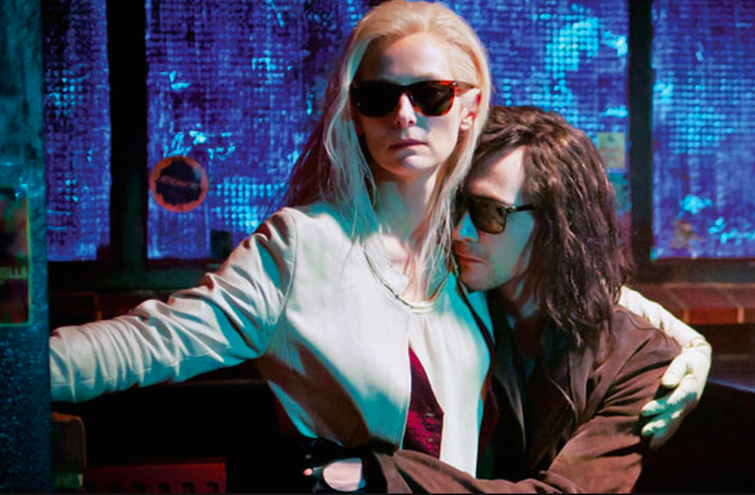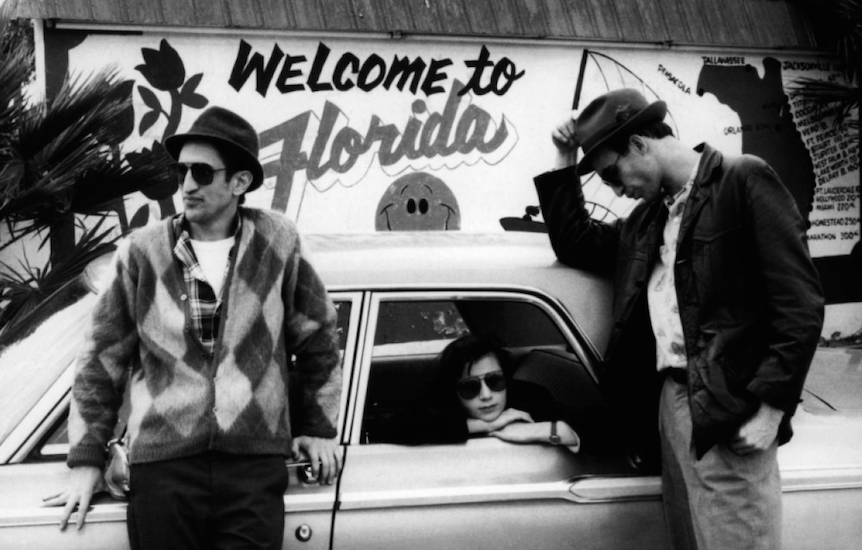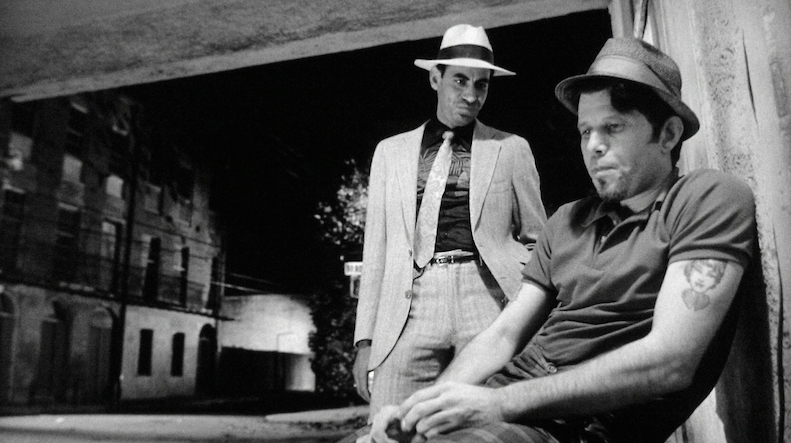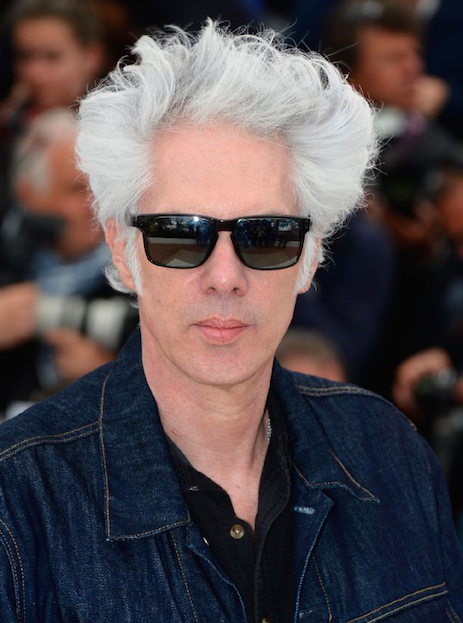The Sound Opinions of Jim Jarmusch

Photos – use only one featuring Tom Waits (probably the Coffee and Cigarettes but its your call)
◆ by Craig J. Clark
A needle is dropped onto a 45. As Wanda Jackson’s recording of Funnel of Love plays, we cut back and forth between spinning overhead views of Tom Hiddleston and Tilda Swinton as two vampires half a world away from each other. Hiddleston, a former classical music composer living off the grid in a blighted Detroit neighborhood, is surrounded by his vintage musical instruments and analog recording equipment. Meanwhile, Swinton lies amongst her vast collection of books in her apartment in Tangier. Even if they’re not in direct contact, this sequence — which opens Jim Jarmusch’s latest film, Only Lovers Left Alive — links them together and, along with their shared affinity for classic Motown and Stax records, connects them to many of Jarmusch’s other music-loving protagonists.
[Image at the top of this post from Only Lovers Left Alive.]
◆
That trend dates back to his 1980 debut, Permanent Vacation, in which the main character is a drifter played by Chris Parker who’s driven by his fixation on his namesake, jazz man Charlie Parker, and little else. The proverbial stranger in a strange land, Parker spends much of the film walking through neighborhoods that look bombed-out, as many areas of New York City did at the time. (Jarmusch felt compelled to invent a war with the Chinese to explain the destruction.) The moment that stands out, though, comes early on when Parker puts on a record (of Up There in Orbit by Earl Bostic) and enthusiastically dances to it in a single, unbroken take. Sure, civilization may be on the brink of breaking down, but one must still take time out for music appreciation.
When Jarmusch came to make his follow-up, 1984’s Stranger Than Paradise, he not only gave the lead role to saxophonist John Lurie (who had briefly appeared as a street musician in Permanent Vacation), but also allowed him to compose the spare score. In fact, if one could only use a single adjective to describe Stranger Than Paradise, “spare” would be a good choice. The film’s minimal plot is set in motion when Lurie’s Hungarian cousin, Eszter Balint, who is fixated on the song I Put a Spell on You by Screamin’ Jay Hawkins, arrives in New York and has to stay with him for ten days before moving on to Cleveland to live with their elderly aunt. When the ten days are up Balint leaves, but not before she makes an impression on Lurie’s best friend, Richard Edson (and on Lurie himself). One year later the two of them spontaneously decide to drive to Cleveland to check up on her and, flush with money, the trio makes for the warmer climes of Florida, but thanks to the black-and-white photography it looks just as bleak as anywhere else they’ve been.
Scene From Stranger Than Paradise
◆
Jarmusch went way out of his comfort zone to make his third feature, 1986’s Down by Law. Sure, he may have sent a few of his characters to Cleveland and Florida in Stranger Than Paradise, but New York City was still their home base. Down by Law, on the other hand, was shot entirely on location in Louisiana, even venturing out into the swamps, which is about as far away from city streets as you can get. It was also his first time working with director of photography Robby Müller, who would go on to shoot three more features for Jarmusch, plus one of his Coffee and Cigarettes shorts, so it’s a fair bet they got on well together. That’s not always a given, but filmmaking is hard enough as it is without throwing your lot in with people you don’t get along with.
That applies to the film as well since Down by Law is a stark, funny portrait of three men thrown together by pure chance who have to band together to overcome the lousy hand life has dealt them. Singer Tom Waits stars as a radio DJ whose girlfriend (Ellen Barkin) tearfully throws him — and most of his possessions — out after he loses yet another gig. John Lurie (who also scored the film) returns from Stranger Than Paradise as a pimp who gets dressed down by one of his girls and falls for a set-up that lands him in jail. The same thing happens to Waits and they wind up sharing a cell in Orleans Parish Prison, where they’re joined by outgoing Italian tourist Roberto Benigni. At first Benigni’s little more than an irritant to Waits and Lurie, who spend most of their time together being openly hostile to each other, but then he figures out how they can escape, which raises his stock with them significantly.
Tom Waits (r) In Down By Law
◆
John Lurie doesn’t appear onscreen in Jarmusch’s next film, 1989’s Mystery Train, but he did compose its score (his last for Jarmusch to date). The same goes for Tom Waits, who is the voice of a late-night DJ whose between-record patter is heard by all three sets of protagonists in the three-part omnibus film set in Memphis, Tennessee. Each story winds up at the same moderately seedy hotel, the Arcade, which is staffed by sharp-dressed desk clerk Screamin’ Jay Hawkins and bellboy Cinqué Lee. The first, “Far from Yokohama,” is about a young Japanese couple (Masatoshi Nagase and Yûki Kudô) on a rock ‘n’ roll pilgrimage — she’s an Elvis girl, he’s into Carl Perkins — who couldn’t be more of a study in contrasts if they tried. In addition to their differing musical tastes — he wants Sun Studios to be their first priority, she’s intent on seeing Graceland — she’s outwardly thrilled by everything, while he’s much more blasé. He also takes pictures of their hotel room (which comes complete with a framed picture of Elvis) since it’s precisely the sort of thing he’ll forget about their trip.
Elvis also factors into the Mystery Train‘s other two stories. In “A Ghost,” Nicoletta Braschi plays an Italian widow traveling to Rome with her husband’s body who has an unplanned stopover in Memphis. She winds up sharing her room at the Arcade with motormouthed Jersey girl Elizabeth Bracco, who has just broken up with her man, but that’s not the reason why she doesn’t get much sleep. Rather, it’s because Elvis’s ghost appears to her, which would go down as the strangest occurrence of the night if not for the events of “Lost in Space,” in which we meet Bracco’s ex, a British expatriate played by rocker Joe Strummer, who’s weary of the nickname his black co-workers have given him (“Elvis,” naturally) and is drowning his sorrows in cheap bourbon. That would be all well and good, but when he starts waving a loaded gun around, his friend (Rick Aviles) and brother-in-law (Steve Buscemi) are summoned to retrieve him, leading to a long night for all of them. Since the previous segments both ended with the characters hearing a gunshot (“Was that a gun?” Kudô asks. “Probably. This is America,” Nagase laconically replies), we know it’s only a matter of time before Strummer shoots off something other than his mouth, and after he wings a liquor store clerk the three of them spend half the night driving around before holing up at the Arcade, where the mystery of the gunshot is solved. Suffice it to say, by the time they’re ready to check out, everybody is more than happy to be on their way.
Music and musicians aren’t as integral to Jarmusch’s next feature, 1991’s Night on Earth (there’s no scene in it like the one in Mystery Train where the Japanese tourists plays Rock Paper Scissors to determine who gets to pick the next tape to put in their Walkman), but Tom Waits did provide its soundtrack. He also acted in Jarmusch’s third Coffee and Cigarettes short in 1995 alongside Iggy Pop, with both of them as themselves having an awkward first encounter. Pop also appeared in a supporting role (as a cross-dressing frontier “wife”) in the same year’s Dead Man, which for our purposes is most notable for being scored by Neil Young. (Jarmusch even slips in a contemporary musical reference by naming one of the characters Benmont Tench after the keyboard player for Tom Petty’s band, the Heartbreakers.) That led to Jarmusch making the 1997 Neil Young and Crazy Horse tour film Year of the Horse, which to date is his only completed documentary (his untitled Stooges doc is currently in post-production).
For 1999’s Ghost Dog: The Way of the Samurai, Jarmusch entrusted the music to Wu-Tang Clan’s RZA, who also gets a cameo as a samurai in camouflage. This paved the way for RZA to act alongside his cousin (and fellow Wu-Tanger) The GZA in the feature version of Coffee and Cigarettes, which was released in 2003 and augmented the first three standalone shorts (which were made over a ten-year period) with eight more. In “Delirium,” the segment featuring RZA and The GZA, the two of them can’t believe their eyes when they find Bill Murray working in a greasy spoon. And in “Jack Shows Meg His Tesla Coil,” Jack White shows his partner in The White Stripes, Meg White, his Tesla coil. (I guess that one’s pretty self-explanatory, actually.) In addition to bringing more musicians into the acting fold, Coffee and Cigarettes found Jim Jarmusch incorporating classic rock and roll sides into the soundtrack once again, with two versions of Louie Louie (one by composer Richard Berry and his group The Pharoahs, the other by Iggy Pop) and Crimson and Clover by Tommy James and Shondells.
Active music listening returns to the fore in Jarmusch’s 2005 film Broken Flowers, in which a reclusive bachelor played by Bill Murray is compelled to visit his old flames when he received an anonymous letter telling him he has fathered a child by one of them. This involves hitting the road with an itinerary planned out by his helpful next-door neighbor (Jeffrey Wright), who also gives him a mix tape to listen to that is heavy on the works of Ethiopian composer/performer Mulatu Astatke. Murray’s character may resist it at first, but the more he listens to it, the more he wants to listen to it.
Four years after Broken Flowers, Jarmusch came out with 2009’s The Limits of Control, in which a laconic man with no name (Isaach De Bankolé, who has been a mainstay of his films since Night on Earth) is sent to Spain to complete a mysterious mission. He meets his contacts in various cafés where they exchange matchboxes — his contain instructions for where he should go next – and have mostly one-sided conversations. (De Bankolé isn’t much for small talk — or talk of any size, really.) One of them is with a curious character played by John Hurt (previously seen in 1995’s Dead Man) who delivers a guitar to him and bends his ear about bohemians. As it turns out, this prefigures an early scene in Only Lovers Left Alive where Tom Hiddleston receives delivery of a number of guitars from dealer Anton Yelchin, who would be his Renfield if only he knew his rock-star client was a vampire.
Jim Jarmusch
◆
In addition to listening to his well-curated vinyl collection, Hiddleston has taken up recording brooding instrumental rock and has even started releasing it. When he grows despondent enough about his lot in unlife to order a .38 caliber wooden bullet from Yelchin, though, Swinton books a night flight from Tangier (where she gets to hang out with Christopher Marlowe, played by John Hurt) to Detroit in the hopes of keeping him from doing anything drastic. The two of them share some pleasant night drives (including a visit to the house where Jack White grew up), but alas, their happy reunion is spoiled when they’re joined by Swinton’s reckless “sister” Mia Wasikowska, who drops in unannounced (save for some portentous dreams) and, as far as Hiddleston is concerned, unwelcome. With Wasikowska stirring the pot, the question isn’t if things are going to go south, but when.
One thing Only Lovers Left Alive does exceedingly well is evoke the creeping boredom that is the bane of undying beings that have an eternity to fill. And since neck-biting is considered passé, something as basic as the acquisition of blood has taken on the air of routine, although Hiddleston does vary his schedule to keep his supplier (a doctor played by Jeffrey Wright) on his toes. Wright, incidentally, is the source of some of the film’s wryer humor, which is most welcome considering how dour Hiddleston can be sometimes. To (mis-)quote the Rolling Stones, what a drag it is not getting old.



